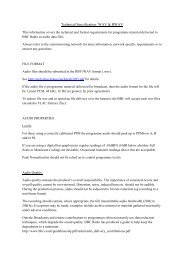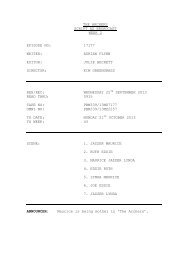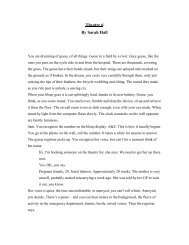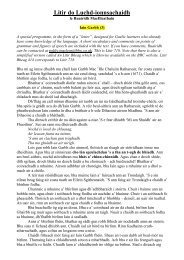50 Great British Inventions - BBC
50 Great British Inventions - BBC
50 Great British Inventions - BBC
Create successful ePaper yourself
Turn your PDF publications into a flip-book with our unique Google optimized e-Paper software.
18<br />
37 Spinning frame<br />
Invented 1768 Inventor RichaRd aRkwRight<br />
Richard Arkwright’s spinning frame – more than James<br />
Hargreaves’s better-known spinning jenny – was the cornerstone<br />
invention of the industrial revolution in textiles that transformed<br />
northern England and lay behind Britain being named the<br />
“workshop of the world”. The spinning jenny made the spinning<br />
of yarn more efficient, but the spinning frame spun thread that<br />
had a tighter weave and was considerably stronger.<br />
Unlike the jenny, the frame was too big to be operated by hand,<br />
so Arkwright had to build what’s often said to be the world’s first<br />
factory in Cromford, Derbyshire, to house the machines. Now<br />
the workers had to come to his premises where, under one roof,<br />
a water mill and, later, steam engines, powered the machines.<br />
It was the cotton threads produced by the spinning frames<br />
that were turned into the cheap “calicoes” that were exported<br />
in huge quantities all over the world. <br />
38 Bessemer<br />
process<br />
Invented 1856 Inventor henRy BesseMeR<br />
Sheffield steelmaker Henry Bessemer didn’t invent<br />
steel production. But his method for simplifying it<br />
and greatly reducing the cost makes the Bessemer<br />
process rank as one of the most important<br />
breakthroughs of the industrial era.<br />
Steel is a combination of iron and a small amount<br />
of carbon. But the process of adding carbon to iron<br />
was extremely time-consuming and used up a huge<br />
amount of fuel. Steelmakers wanted to use “pig iron”,<br />
a cheap and plentiful product that had too much<br />
carbon in it, but they couldn’t work out how to get<br />
the carbon out. Bessemer managed to do that by<br />
pumping high-pressure air through the molten pig<br />
iron. It was assumed the air would cool the iron,<br />
but the oxygen in the air actually burnt off<br />
carbon in the iron and, in doing so, it raised<br />
the temperature. This accelerated the process<br />
and the result was hotter, purer iron that could<br />
be converted to steel much more easily. <br />
39 Electric motor<br />
Invented 1821 Inventor Michael FaRaday<br />
Michael Faraday was employed by the Royal Institution, where he<br />
investigated the connections between electricity, magnetism and<br />
motion. In 1821, he demonstrated electromagnetic rotation for the<br />
first time. A free-hanging wire was dipped into a pool of mercury<br />
that had a fixed magnet in it. When an electric current was passed<br />
through the wire, it rotated around the magnet – the electricity<br />
produced a magnetic field around the wire, which interacted with<br />
the magnet in the mercury. This was the world’s first electric motor.<br />
Ten years later, Faraday made an incredible intellectual leap: if<br />
electricity and magnetism could create motion, could the reverse<br />
be true – could motion and magnetism create electricity? Faraday<br />
proved it could with the world’s first electric generator, a copper disk<br />
that rotated between the poles of a magnet and generated a current<br />
in a wire attached to it by a spring. <br />
LEARN MORE<br />
visit the royal<br />
institution’s<br />
michael<br />
faraday museum<br />
in london to see<br />
faraday’s<br />
magnetic<br />
laboratory<br />
as it was in<br />
the 18<strong>50</strong>s.<br />
40 Hydraulic press<br />
Invented 1795 Inventor Joseph BRaMah<br />
Locksmith Joseph Bramah made famously<br />
unpickable locks and was also a keen<br />
inventor. Of all his developments, the one<br />
that has had the most impact was the<br />
hydraulic press, which he patented in 1795.<br />
In a hydraulic press, two piston cyclinders,<br />
with different cross-sectional areas, are<br />
connected with a tube and filled with fluid<br />
– oil, for example – so that moving one<br />
piston will cause the other one to move, too.<br />
According to Pascal’s principle (originated<br />
RadioTimes <strong>50</strong> <strong>Great</strong> <strong>British</strong> <strong>Inventions</strong><br />
DID YOU KNOW?<br />
Joseph<br />
bramah’s other<br />
inventions<br />
include<br />
fountain pens,<br />
paper-making<br />
machines, hand<br />
pumps for beer<br />
and the<br />
flushing toilet.<br />
by French mathematician Blaise Pascal), the<br />
pressure inside a closed system is constant,<br />
so a small force applied to move the small<br />
piston a large distance translates to a large<br />
force pushing the large piston a small<br />
distance. Bramah used the press to make<br />
parts for his locks: by pushing the small<br />
piston, he could slowly flatten metal with<br />
the large piston. The hydraulic press is<br />
today one of the most useful and widespread<br />
machine tools. <br />
dick and doM<br />
41 Sewage<br />
system<br />
Invented 1865<br />
Inventor Joseph Bazalgette<br />
there are certain<br />
inventions and<br />
creations that people<br />
are aware of every day.<br />
there are very few<br />
creations that we use<br />
our whole lives without<br />
ever thinking about or<br />
even seeing. But that<br />
is exactly what the London sewers are.<br />
their creator, Joseph Bazalgette, may<br />
be remembered as more of an engineer<br />
than an inventor, but what he developed<br />
in London — the largest and most forwardthinking<br />
sewage system the world had ever<br />
seen — changed life in the city completely.<br />
there was a sewage system in place<br />
beforehand, but all it did was transfer waste<br />
straight into the thames. It was basically<br />
one massive open sewer pipe. By all<br />
accounts it created a truly awful smell,<br />
reaching its peak during the <strong>Great</strong> Stink<br />
of 1858. even more worryingly, it caused<br />
serious health problems, such as cholera,<br />
because it contaminated the city’s drinking<br />
supply. Something had to be done, and<br />
Bazalgette was the man to do it.<br />
His solution was phenomenal: a new<br />
waste system that would divert the sewage<br />
eastwards away from the river and pump<br />
it out to sea. By 1865 most of the system<br />
was working, the main intercepting sewers<br />
used 318 million bricks and measured over<br />
80 miles in length. to do all that work<br />
above ground would have been one thing,<br />
but to create it underground was something<br />
else altogether. We got the opportunity to<br />
go down there, and even though we saw<br />
and smelt things we couldn’t describe in<br />
a family magazine, the intricate maze of<br />
sewer pipes more than 100 years old was<br />
just unbelievable. And the most amazing<br />
thing is that it still functions today.<br />
the reason is that when Bazalgette<br />
designed the tunnels, he estimated how<br />
much the population of London would<br />
increase in the next 100 years and worked<br />
out how large the tunnels would need to<br />
be to meet the needs of the future and<br />
keep the system flowing. Which is why the<br />
sewers are still in working order today, and<br />
why in our eyes it should be seen as a huge<br />
inventing achievement. <br />
Watch Absolute Genius with Dick and Dom<br />
on C<strong>BBC</strong> later this month<br />
19

















